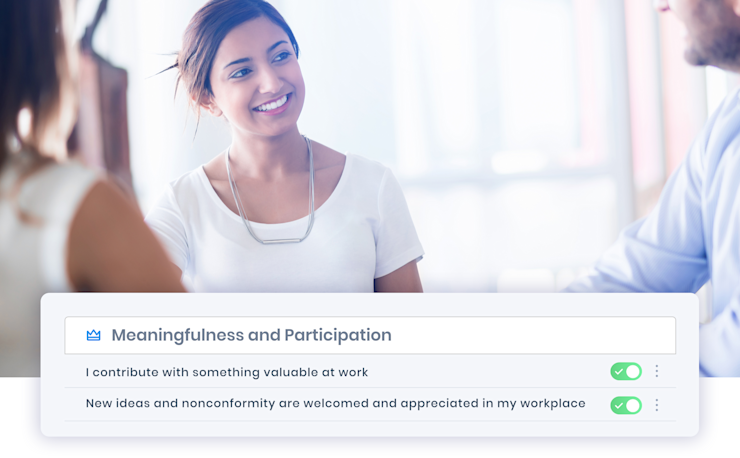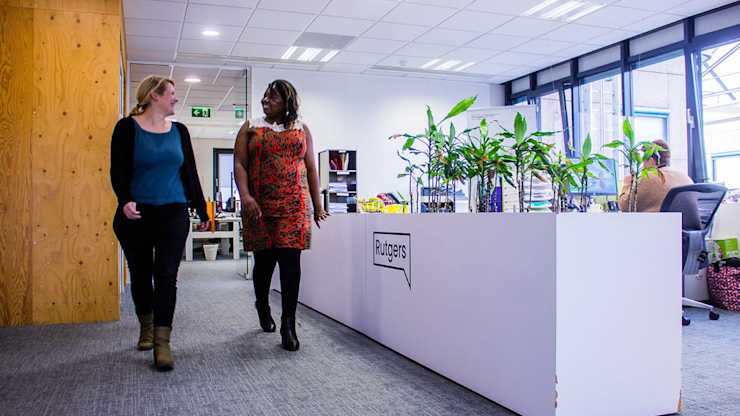As the world becomes increasingly interconnected and reliant on digital solutions, organisations must adapt to harness the power of technology in fostering a strong company culture.
According to Moneyzine “50% of employees believe an organisation’s approach to their performance defines company culture”.
By following the steps in this post, you can leverage technology effectively.
We’ll show you everything. From establishing clear goals and objectives to promoting transparency through data-driven decision-making processes.
Not only will your organisation benefit from increased employee engagement but also improved overall performance.
Start transforming your company culture using technology!
Defining positive organisational culture
So, what exactly is a positive organisational culture?
We think it’s a beneficial atmosphere that encourages joint effort, reliance, and two-way correspondence among its members.
A healthy workplace culture promotes employee engagement and satisfaction while boosting overall performance.
Now that we've got the definition right, let's dive into why it matters so much for your company.

Benefits and importance of a positive organisational culture
Creating a positive organisational culture is not just about making employees happy; it's an investment in your company's long-term success.
Here’s what it brings to the table…
Better Employee Engagement: According to a Gallup study, highly engaged teams show 21% greater profitability. We have a wide range of employee engagement features at Eletive so you can take that even further.
Innovation Boost: When employees feel supported and valued, they're more likely to think outside the box and contribute innovative ideas.
Talent Attraction and Retention: Top talent wants to work for companies with great cultures. In fact, Harvard Business Review states that a strong culture can reduce turnover by up to 50%.
Better Customer Satisfaction: Happy employees lead to happy customers. According to a McKinsey report, improving customer experience can increase revenue by up to 15% while lowering costs by as much as 20%.
Growth Acceleration: A positive culture fuels growth through increased productivity and collaboration among team members.
Nellie Hayat is a thought leader in the Future of Work movement and has worked with some of the most innovative companies in the world to help design their employee experiences.
She shared her thoughts with us in the video below…
Characteristics of a positive organisational culture
Let's dive into the key traits that define a positive organisational culture.
These characteristics not only foster employee satisfaction but also drive business success.
Open Communication: A culture where employees feel comfortable sharing ideas, concerns, and feedback is crucial for growth
Inclusivity & Diversity: Embracing different perspectives and backgrounds leads to innovation and creativity. Learn how to promote diversity in your workplace with this insightful Built In guide.
Growth Opportunities: Employees thrive when they have access to professional development resources
Acknowledgment & Recognition: Show appreciation for hard work by celebrating achievements regularly
Work-Life Balance: Encourage employees to maintain a healthy balance between their personal and professional lives.
Now that you know the essentials, it's time to start building a positive organisational culture with technology.

How to create a positive organisational culture with technology
1. Establish clear goals and objectives
Well, having well-defined targets helps everyone stay focused on what really matters: the organisation's mission.
Here are some tips for developing effective goals:
Specific: Clearly define what you want to achieve.
Measurable: Determine how success will be measured (e.g., increased employee engagement).
Achievable: Ensure that your goals are realistic given available resources and time constraints.
Relevant: Align your objectives with the organisation's overall mission and values.
Timely: Set deadlines for when each goal should be accomplished.
With these SMART criteria in mind, you can establish meaningful objectives that will guide your efforts towards creating a positive company culture using technology.
2. Integrate technology
By leveraging technology, you can create a more positive and efficient work environment for your employees.
Here’s what we recommend getting started with:
#1: Implement employee engagement platforms, like Eletive, to gather feedback and measure employee satisfaction.
#2: Use project management tools such as Trello or Asana to streamline workflows and improve collaboration among team members.
#3: Encourage remote working with video conferencing apps like Zoom or Google Meet.
Beyond these basics, consider adopting cutting-edge technologies that align with your organisation's values and goals. A few examples include:
Virtual reality training programs for skill development
Gamification techniques to motivate employees
AI-powered analytics tools for data-driven decision-making
Remember: it's not just about using any technology - it's about choosing the right solutions that foster a positive organisational culture.
3. Encourage user engagement and adoption
When introducing new technologies, it is crucial to prioritise user engagement and adoption to avoid resistance and foster a sense of connection.
Consider implementing the following strategies:
Inclusive Decision-Making: Create focus groups or committees to assess and choose new technologies. Seek their feedback, concerns, and suggestions, fostering collaboration and strengthening their connection to the technology. This will help you get buy-in.
Recognising Early Adopters: Identify and publicly acknowledge employees who embrace and excel in utilising new technologies. Showcase their achievements and encourage others to follow suit.
Continuous Training and Support: Provide comprehensive training programs to ensure employees feel confident and proficient when using new technologies.
Download: Establishing a Feedback Based Culture
4. Promote transparency
When employees are well-informed and included, they become more engaged, motivated, and connected to the company's mission.
Here's how you can foster transparency within your organisation:
Open Communication: Establish accessible channels for employees to express their thoughts and ideas. Utilise team meetings, virtual suggestion boxes, or dedicated platforms to encourage open dialogue, active listening, and prompt responses.
Share Updates: Keep employees informed about significant company news, milestones, and decisions. Use internal newsletters or intranets to consistently share information.
Transparent Performance: Implement clear performance evaluation processes and provide regular feedback. Communicate performance expectations, goals, and metrics effectively. Encourage managers to engage in open and constructive conversations that support professional growth. Transparent performance management cultivates fairness, trust, and accountability.
Remember, practising transparency consistently and authentically establishes trust, empowers employees, and strengthens their connection to the organisation.
By nurturing transparency, you foster a positive organisational culture based on openness, collaboration, and mutual respect.
Download: Why should we boost self-leadership
5. Reward performance: celebrate your employees' success
Let's face it, everyone loves recognition.
Acknowledging your employees' hard work is crucial in fostering a positive organisational culture.
Here are some actionable tips to effectively reward performance:
Step 1: Implement rewards programs, such as bonuses or promotions, that motivate and inspire your team members.
Step 2: Encourage peer-to-peer recognition by creating an online platform where colleagues can praise each other for their accomplishments.
Step 3: Offer non-monetary rewards like flexible working hours or additional vacation days to show appreciation for exceptional contributions.
That’s it, 5 steps for building a positive organisational culture with technology.
Our employee engagement platform has helped numerous clients transform. We’ll look at a couple of real life examples in the next section…
Examples of successful implementation of technology in creating a positive organisational culture
Dole
Dole implemented Eletive to create a positive organisational culture through proactive leadership and employee engagement.
By conducting monthly pulse surveys and utilising the Employee Net Promoter Score (eNPS), Dole gained valuable insights, automated the survey process, and empowered leaders to drive positive change.

Rutgers
Previously, Rutgers relied on traditional annual surveys that provided limited insight into employee satisfaction.
Recognizing the need for a more dynamic approach, they adopted Eletive for real-time feedback and engagement metrics.
With Eletive, Rutgers established a feedback-driven culture, empowering employees and managers to take ownership of their experiences.
Our platform's intuitive design and customizable questionnaires facilitated real-time insights and self-leadership among individuals.
This shift resulted in a more open and transparent communication culture, where feedback led to actionable improvements.

Conclusion
In conclusion, creating a positive organisational culture with technology is crucial for the success of any business.
A positive culture leads to higher employee engagement, productivity, and retention rates.
Key components in building a positive organisational culture include clear goals and objectives, collaboration, transparency, and performance recognition.
Using a branded employee engagement platform like Eletive can help you build that culture. It’s now faster and easier than ever before.
Contact sales here for a live demo!
FAQ
How does technology influence organisational culture?
Technology plays a significant role in shaping organisational culture by enhancing communication, collaboration, and efficiency. It enables organisations to implement flexible work arrangements, streamline processes, and facilitate data-driven decision-making. Additionally, technology fosters innovation and adaptability within the organisation.
How do you build culture in a tech company?
To build a strong culture in a tech company:

























